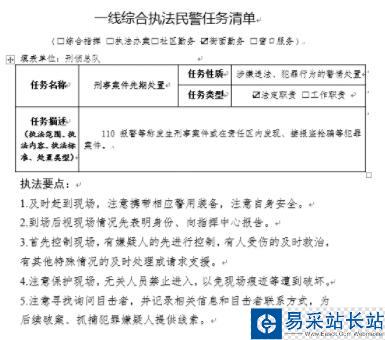表格内容如下:

1、实现批量导入word文档,取文档标题中的数字作为编号
2、除取上面打钩的内容需要匹配出来入库入库,其他内容全部直接入库mysql
# wuyanfeng# -*- coding:utf-8 -*-# 读取docx中的文本代码示例import docximport pymysqlimport reimport os# 创建数据库链接conn = pymysql.connect( host='rm-bp1vu5d84dg12c6d59o.mysql.rds.aliyuncs.com', port=3306, user='root', passwd='wYf092415*', db='pays', charset='utf8',)# 创建游标cursor = conn.cursor()#切片函数def section(info,key,len11): a = len(info) print(a, type(a)) d = [] e = 0 g = -1 i = 0 task_class=[] while i < len(info): # for i in range(len(info)): # i+=1 print("i::::", i) try: #c = info.index("a", e) #print("c:::::", c) c = info.index(key, e) #print("c:::::", c) print("c类型判断",type(c)) except ValueError: print(ValueError) try: if (c != '') & (g < int(c)): d.append(c) g = c i = c + 1 print("illlldddd:", i) e = c + 1 continue elif (c == ''): break except UnboundLocalError: print(UnboundLocalError) return task_class break print("d", d, type(d)) print(d[0], type(d[0])) print("d的长度:",len(d)) #开始切片 if len(d) != 0: for j in range(len(d)): print("info11:::", info, type(info)) info = ''.join(info) print("info222:::",info,type(info)) print("d[%d]"%j,d[j]) #print("d[j]:5"%j,info[d[j]:5]) llll = info[d[j]+1:d[j]+5] print("d[%d]:5" % j, llll) task_class.append(llll) print("task_class::11", task_class) task_class=",".join(task_class) print("str1112222",task_class) return task_classdef insettable(file): print("file::::::::::::::::::::", file) print("type::::::::::::::::::::", type(file)) # file1 = file # file1 = str(file1) ddd = re.findall("知识库///(/d+)", file) print("ddd:::::::::::", ddd) print("ddd[0]:::", ddd[0]) ddd = int(ddd[0]) print("ddd::::", type(ddd)) file = docx.Document(file) # 读取表格: t = file.tables[0] print(t) print("1:", t.cell(0, 0).text) # 1 cell1 = t.cell(0, 0).text print("tyep::::", type(t.cell(0, 0).text)) print("2:", t.cell(0, 1).text) # 2 cell2 = t.cell(0, 1).text print("2:", t.cell(0, 2).text) # 2 cell3 = t.cell(0, 2).text print("2:", t.cell(0, 3).text) # 2 cell4 = t.cell(0, 3).text print("cell4:::::::::", cell4) print("3:", t.cell(1, 0).text) # 3 cell5 = t.cell(1, 0).text print("4:", t.cell(1, 2).text) # 4 cell6 = t.cell(1, 2).text print("5:", t.cell(1, 3).text) # 5 task_type = t.cell(1, 3).text # task_type = re.findall('.*[☑√](.*)$', cell7) # task_type = ''.join(cell7) print("task_type111111:", task_type) # task_class = task_class[0:4] '''低级处理方式 a = int(task_type.count("☑")) print("a|||||||", a, type(a)) b = int(task_type.count("√")) print("b|||||||", b, type(a)) if (a == 1) | (b == 1): print("111111111111111111") # task_type = re.findall('.*[☑√](.*)$', task_type) task_type = re.findall('.*[☑√](.*)$', task_type) print("task_type1", task_type) task_type = ''.join(task_type) print("task_type2", task_type) task_type = task_type[0:4] print("task_type3:d:%s,b=%d" % (a, b), task_type) elif (a == 0) & (b == 0): print("2222222222222222222") task_type = '法定职责' print("a:%s,b=%s" % (a, b), task_type) elif (a == 2) | (b == 2): print("333333333333333333333") task_type = '法定职责,工作职责 ' print("a:%s,b=%s" % (a, b), task_type) ''' #调用切片函数 task_type1 = section(task_type, "√", 4) task_type2 = section(task_type, "☑", 4) task_type1 = "".join(task_type1) task_type2 = "".join(task_type2) print("task_type1:::", task_type1,type(task_type1)) print("task_type2:::", task_type2,type(task_type2)) if task_type1.strip()!="": task_type = task_type1 print("task_type111:::", task_type1) elif task_type2.strip()!="": task_type = task_type2 print("task_type222:::", task_type2) print("6:", t.cell(1, 4).text) # 6 cell8 = t.cell(1, 4).text print("7:", t.cell(2, 1).text) # 7 cell9 = t.cell(2, 1).text # 获取文档对象 # file = docx.Document("D://配置库//公案APP//1.2 系统规格//知识库//14人员死亡先期处置.docx") print("段落数:" + str(len(file.paragraphs))) # 段落数为13,每个回车隔离一段 lenn = len(file.paragraphs) print("len:", lenn) # 输出每一段的内容 for para in file.paragraphs: print(para.text) # 输出段落编号及段落内容 for i in range(len(file.paragraphs)): print("第" + str(i) + "段的内容是:" + file.paragraphs[i].text) list6 = [] for i in range(len(file.paragraphs)): if 0 == i: print("i:", i) lis0 = file.paragraphs[i].text print("list0:", lis0) print(type(lis0)) elif 1 == i: print("i:", i) task_class = file.paragraphs[i].text print("lis1", task_class,type(task_class)) '''低级处理方式 print("task_class111111:", task_class) c = int(task_class.count("☑")) task_class = ''.join(task_class) #print(task_class.index('☑')) print("c|||||||", c, type(c)) d = int(task_class.count("√")) print(task_class.index('√')) print("d|||||||", d, type(d)) task_class = re.findall(r'[☑√](?:.*)', task_class) task_class = ''.join(task_class) task_class = task_class[1:5] print("task_class", task_class) ''' #调用切片函数 task_class1 = section(task_class, "√", 4) task_class2 = section(task_class, "☑", 4) task_class1 = "".join(task_class1) task_class2 = "".join(task_class2) print("task_class1:::", task_class1,type(task_class1)) print("task_class2:::", task_class2,type(task_class2)) if task_class1.strip()!="": task_class = task_class1 print("task_class11:::", task_class1) elif task_class2.strip()!="": task_class = task_class2 print("task_class22:::", task_class2) if 2 == i: print("i:", i) lis2 = file.paragraphs[i].text print("lis2", lis2) print(type(lis2)) preparer = re.findall('填表单位:(.*?)$', lis2) preparer = ''.join(preparer) print("preparer:%s" % preparer) # elif 3 == i: # print("i:", i) # lis3 = file.paragraphs[i].text elif 3 == i: print("i:", i) lis4 = file.paragraphs[i].text print("lis4", lis4) print(type(lis4)) elif 3 < i < lenn - 1: print("i:", i) print(file.paragraphs[i].text) print(type(file.paragraphs[i].text)) # list6[i-5] = list6.append(file.paragraphs[i].text) list6.append(str(file.paragraphs[i].text).strip('/xa0')) # list6.append("%s/n" % str(file.paragraphs[i].text).strip('/xa0')) print(list6) key_steps = "/n".join(list6) # print("key_steps:/n",key_steps.strip('/n')) cursor.execute( "insert into `t_knowledge_base` (`no`, `preparer`, `task_class`, `task_name`, `task_specification`, `task_type`, `task_desc`, `task_basis`, `key_steps`) values ('%d','%s','%s','%s','%s','%s','%s',NULL,'%s')" % ( ddd, preparer, task_class, cell2, cell4, task_type, cell9, key_steps)) conn.commit()def traverse(f): fs = os.listdir(f) for f1 in fs: tmp_path = os.path.join(f, f1) if not os.path.isdir(tmp_path): print('文件: %s' % tmp_path) insettable(tmp_path) else: print('文件夹:%s' % tmp_path) traverse(tmp_path)path = 'D://配置库/公案APP//1.2 系统规格//知识库'traverse(path)#单文件调测# path = 'D://配置库//公案APP//1.2 系统规格//知识库//14人员死亡先期处置.docx'# insettable(path)# 关闭游标cursor.close()# 关闭连接conn.close()
新闻热点
疑难解答